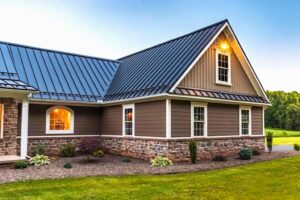
Your roof acts as the guardian of your home, shielding you from the elements and ensuring the structural integrity of your property. But just like any other part of your house, roofs require regular maintenance and care to function optimally. Neglecting your roof can lead to costly repairs down the line, potential water damage, and even safety hazards.
This comprehensive guide empowers you to become roof-ready, equipping you with the knowledge and essential tips to keep your roof healthy and your home protected from the elements.
Understanding Your Roof: Types and Materials
The first step to effective roof maintenance is understanding the type of roof you have and the materials used. Here’s a breakdown of some common roof types:
- Asphalt Shingles: The most common and affordable roofing material, offering a good balance of durability and affordability. Shingle lifespan typically ranges from 15-30 years.
- Metal Roofs: Durable and long-lasting, with lifespans exceeding 50 years in some cases. Metal roofs can be more expensive upfront but offer excellent protection from the elements.
- Tile Roofs: A timeless and elegant choice, offering excellent durability and fire resistance. Tile roofs are typically more expensive than asphalt shingles and require specialized installation.
The Importance of Regular Inspections
Regular roof inspections are crucial for identifying potential problems early on. Aim to have your roof inspected by a qualified professional at least once a year, and more frequently if you live in an area prone to harsh weather conditions. Here are some benefits of regular inspections:
- Early Detection of Damage: Early detection of minor issues like loose shingles or clogged gutters can prevent them from escalating into major repairs.
- Maximized Roof Lifespan: Regular maintenance and addressing minor issues promptly can significantly extend the lifespan of your roof.
- Enhanced Peace of Mind: Knowing your roof is in good condition provides peace of mind and allows you to focus on enjoying your home.
DIY Maintenance Tips for Roof Readiness
While some roof maintenance tasks require professional expertise, there are steps you can take to keep your roof in good condition:
- Clean Your Gutters: Clogged gutters can cause water to back up under the roof shingles, leading to leaks and potential water damage. Clean your gutters regularly, especially after heavy rainfall or storms.
- Trim Overhanging Branches: Overhanging branches can scrape against your roof shingles and cause damage. Trim any branches that come too close to your roofline.
- Moss Removal: Moss growth on your roof can trap moisture and create a breeding ground for mold. If you notice moss growth, consider professional cleaning to prevent further problems.
When to Call in the Professionals
While some maintenance tasks are manageable, certain situations require professional intervention:
- Missing or Damaged Shingles: Missing or damaged shingles expose the underlying roof structure to the elements and require prompt repair by a qualified roofer.
- Visible Leaks: If you notice any leaks in your ceiling or walls, it’s a clear sign of roof damage and necessitates immediate professional attention.
- Flashing Issues: Flashing (sealing material around chimneys and vents) can deteriorate over time. If you suspect flashing issues, consult a professional for repairs.
Roof Replacement: Understanding the Signs
Roofs, like any other building material, have a finite lifespan. Here are some signs that indicate a potential roof replacement may be necessary:
- Age: Asphalt shingle roofs typically last 15-30 years. If your roof is approaching or exceeding this age, consider scheduling a professional inspection to assess its condition.
- Curling or Cracked Shingles: Curling or cracked shingles indicate wear and tear and compromise the roof’s waterproofing abilities.
- Extensive Moss Growth: While some moss growth is manageable, extensive moss can signal underlying roof problems and necessitate professional assessment.

Beyond the Basics: Roof Maintenance for Different Seasons
Here are some seasonal considerations for optimal roof maintenance:
- Spring: Clean gutters after winter debris accumulates. Perform a visual inspection for any damage caused by harsh winter weather.
- Summer: Extreme heat can cause asphalt shingles to crack. Ensure proper ventilation in your attic to prevent excessive heat buildup.
- Fall: Clear gutters before fall foliage accumulates. Trim tree branches that may have grown close to the roofline over the summer.
- Winter: Heavy snowfall can put stress on your roof. Ensure proper drainage to prevent ice dams from forming.
The Final Tile: Investing in Your Roof’s Longevity
By following these essential tips, you can become a roof-ready homeowner, equipped to keep your roof healthy and your home protected for years to come. Remember:
- Prevention is Key: Regular maintenance and addressing minor issues promptly are far more cost-effective than dealing with major repairs down the line.
- Choose Your Professionals Wisely: When hiring a roofer, ensure they are licensed, insured, and have a proven track record of quality work. Obtain multiple estimates and ask for references before making a decision.
- Don’t Ignore Warning Signs: Ignoring signs of roof damage can lead to more extensive problems and potentially higher repair costs. Address any concerns promptly to prevent further issues.
Related: Loud and Clear: What to Expect During Your Roof Replacement
Roof Readiness: A Year-Round Commitment
Maintaining a healthy roof is a year-round commitment. By incorporating these tips into your home maintenance routine and scheduling regular professional inspections, you can ensure your roof continues to safeguard your home for years to come. A well-maintained roof not only protects your home from the elements but also contributes to its overall value and curb appeal.
So, take charge of your roof’s health today! Embrace the power of roof readiness and enjoy the peace of mind that comes with knowing your home is well-protected from the elements.







